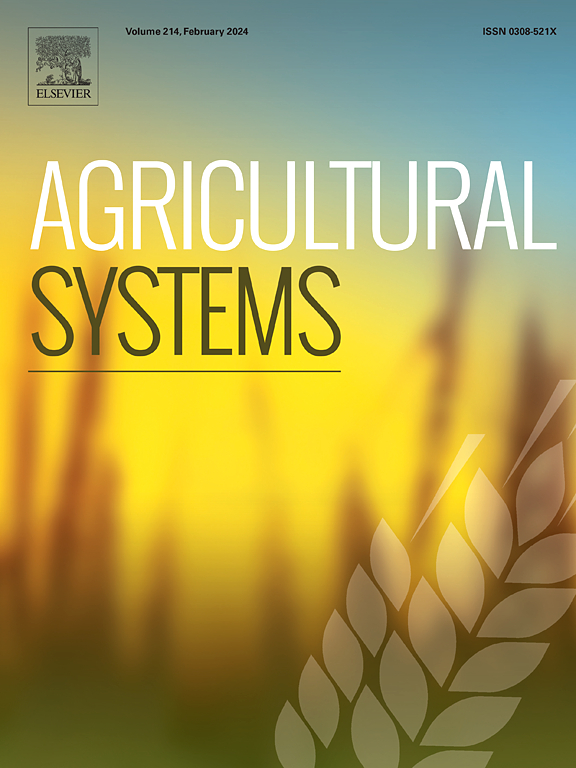Analyzing the factors driving the adaptability and robustness of mixed ruminant herds in grassland systems
IF 6.1
1区 农林科学
Q1 AGRICULTURE, MULTIDISCIPLINARY
引用次数: 0
Abstract
CONTEXT
Diversified systems that work to agroecology principles are a pathway worth exploring. However, the complexity of these systems and their high dependency on environmental conditions creates issues around the methods needed to assess them and the proxies needed to design them.
OBJECTIVE
The aim of this article is to characterize the robustness and adaptability of mixed herds in the face of environmental hazards. It also aims to identify the structural drivers (herd size and composition) of these two properties.
METHODS
Here we used the viability theory modelling approach calibrated on data from a long-term experiment to investigate the adaptability and robustness of mixed ruminant herds to meteorological and economic hazards, and their structural drivers. We applied our model to grass-based dairy-cattle and suckler-sheep herds.
RESULTS AND CONCLUSIONS
Results show that expected economic constraint is a determinant factor in the shape and composition of viable herds. Herd size and proportion of adult cattle in the herd are drivers of robustness in situations of uncertainty. The results also show that mixed herds are particularly valuable in situations with low economic requirements, especially in terms of herd adaptability to environmental hazards.
SIGNIFICANCE
Our results are consistent with existing mixed systems in western Europe but call for a change in the scale of analysis to include farm-level dynamics, associated management practices (land-use trade-offs, forage management, etc.) and uncertainties. This work questions the specialization of livestock farms and public policies to support agroecological transition and emergency aid for farmers.

草地系统中混合反刍兽群适应性和鲁棒性的驱动因素分析
符合农业生态学原则的多样化系统是一条值得探索的道路。然而,这些系统的复杂性及其对环境条件的高度依赖,在评估它们所需的方法和设计它们所需的代理方面产生了问题。目的研究混合畜群在环境危害面前的稳健性和适应性。它还旨在确定这两个属性的结构驱动因素(群体规模和组成)。方法基于长期实验数据,采用生存力理论建模方法,研究混合反刍兽群对气象和经济灾害的适应性、稳健性及其结构性驱动因素。我们将我们的模型应用于以草为基础的奶牛和乳羊群。结果与结论结果表明,预期经济约束是影响畜群形态和组成的决定性因素。在不确定的情况下,牛群规模和成年牛的比例是稳健性的驱动因素。结果还表明,混合畜群在经济要求较低的情况下特别有价值,特别是在畜群对环境危害的适应性方面。我们的结果与西欧现有的混合系统一致,但需要改变分析的规模,包括农场层面的动态,相关的管理实践(土地利用权衡,饲料管理等)和不确定性。这项工作对畜牧业的专业化和支持农业生态转型的公共政策以及对农民的紧急援助提出了质疑。
本文章由计算机程序翻译,如有差异,请以英文原文为准。
求助全文
约1分钟内获得全文
求助全文
来源期刊

Agricultural Systems
农林科学-农业综合
CiteScore
13.30
自引率
7.60%
发文量
174
审稿时长
30 days
期刊介绍:
Agricultural Systems is an international journal that deals with interactions - among the components of agricultural systems, among hierarchical levels of agricultural systems, between agricultural and other land use systems, and between agricultural systems and their natural, social and economic environments.
The scope includes the development and application of systems analysis methodologies in the following areas:
Systems approaches in the sustainable intensification of agriculture; pathways for sustainable intensification; crop-livestock integration; farm-level resource allocation; quantification of benefits and trade-offs at farm to landscape levels; integrative, participatory and dynamic modelling approaches for qualitative and quantitative assessments of agricultural systems and decision making;
The interactions between agricultural and non-agricultural landscapes; the multiple services of agricultural systems; food security and the environment;
Global change and adaptation science; transformational adaptations as driven by changes in climate, policy, values and attitudes influencing the design of farming systems;
Development and application of farming systems design tools and methods for impact, scenario and case study analysis; managing the complexities of dynamic agricultural systems; innovation systems and multi stakeholder arrangements that support or promote change and (or) inform policy decisions.
 求助内容:
求助内容: 应助结果提醒方式:
应助结果提醒方式:


